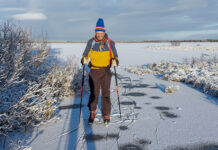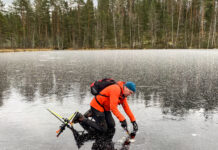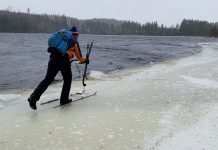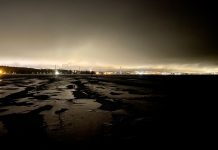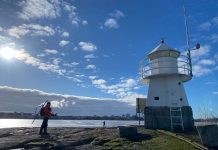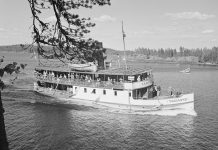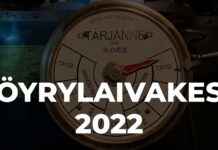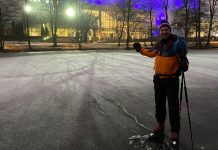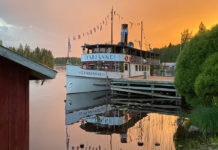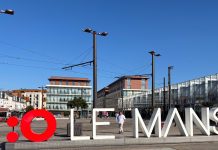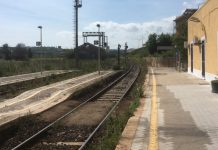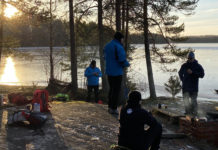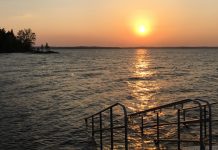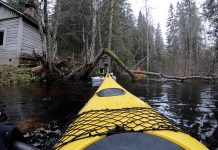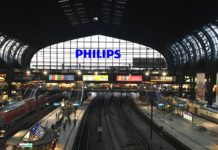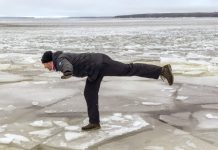I have been on diverse steamboat trips, but there is one that I will never forget: the trip to 308th anniversary of St. Petersburg in 2011. The Finnish Steam Yacht Association had been invited to celebrate the anniversary and 12 steamboats and 2 old diesel (former steamers) had accepted the invitation. This “steamboat regatta of St. Petersburg” had been prepared a long time by the officials of the association and the Russian organizers and the regatta itself was just the culmination of the work. For me, this trip was unique also in the sense that it was the first time on lake Saimaa as well. But did all this happen from my point of view?
Invitation to the steamboat Hurma
I was working in the University of Tampere in the spring of 2011 and I was just visiting a customer of a tourism research project when my phone rang. It was probably in February. A acquaintance of mine from the Finnish Transport Safety Agency called and asked if I was interest to participate in a steamboat trip to St. Petersburg as a shipmaster of the steamboat Hurma (of the biofore company UPM) in May. The regular shipmasters of Hurma were unable to leave due to their other work and the regulation stated that the shipmaster had to be the same for the duration of the regatta. I promised get back to this matter—feeling childlike enthusiasm—but I had ask the permission to leave from my current employer. This worked out with a one phone call and I was ready to discuss about the details of this trip with chief engineer of Hurma: His company was operating Hurma on behalf of UPM.
The details of the contract and trip were quickly agreed on and I promised to arrive to the homeport of Hurma, Kanavansuun perinnelaivatelakka, on Saturday morning: the time of departure was on Monday. Kimmo also told that there was to be a lot of work for the weekend preparing the steamer ready for the trip at sea.
Setting off for Lappeenranta
I was living in Estonia at the time due to one travel research project. So when May arrived I travelled first from Tallinn to Tampere via Helsinki. As my flat at Tampere looked more like a store than a flat for living, it took a while to search all the necessary equipment for the trip. Finally I was ready to take the train to Lappeenranta with my backpack, garment cover, laptop case and more ‘style-fitting’ plywood luggage. Quite a cargo for two weeks…

On the way to Lappeenranta I made one ‘small’ error which could have harmed all the trip for all the others as well. As I took a taxi from Lappeenranta railway station to the homeport of Hurma (about 10 kms), I noticed in the middle of the ride that I had left my laptop case (the one on the picture above) on the bench next to the railway station. I told the taxi driver make a u-turn and drive to the station as fast as he could. Losing the laptop would have been only material loss but in the same case, there was my passport and visa to Russia as well. I had been listed as the shipmaster of Hurma for various official documents and I could not leave, no-one could. The 5 minutes taxi drive back to the station was one of the longest of my life and I went through quite a range of emotion. Luckily, when we arrived back to the staton, the laptop case was waiting me just where I had left it. Honest people living at Lappeenranta!

Weekend went fast aboard Hurma. The ship was equipped to meet the requirements of the exceptional sea journey. A lot of crew lists were printed in advance—and luckily enough, Kimmo took the printer with us to the trip as so many crew lists were required by the Russian officials. I examined closely also the maps of the route: the paper ones already aboard and the ones that we had got from the organizers. One of the most important tools for the trip was the stamp. Stamps were required by the officials to every paper. We had even two kinds of stamps: a rectangle one of the UPM and round one of Kaukas Ltd (that had not existed for years). It proved out that the round one was better for officials documents, so we used that one for the rest of the trip. Later I heard that one steamboat had used a round Moomin stamp to meet the requirements…
The primary feeling that I can remember of that weekend was a mixture of excitement and eagerness: for me, this was the first trip on lake Saimaa, aboard Hurma, and with new crew. Besides these, on lake Näsijärvi where I had worked for several years, there is not much VHF traffic and the Saimaa Canal is a bit different compared to those of Murole and Herraskoski of which I had grown so familiar with. And of course, the destination of the trip was Russia, which is always a different thing. (It had to be said, that the political situation in 2011 was quite different from current one. It’s a pity how things have gone). Even if these factors hadn’t been enought to produce excitement, Kimmo told me a couple of weeks before departure that the Finnish Broadcasting Company (Yle) would send a reporter and a cameraman aboard and there would be some kind of reportage on the national tv afterwards. This news was the icing on the cake!
From Lappeenranta to Vyborg on 23th of May 2011
Finally the long-awaited Monday morning arrived and we set off. The first part of the journey was made with passengers until the Nuijamaa border station. There other passengers would leave and those coming with us all the way to St Petersburg would hop in. On this first leg, the old shipmaster of Hurma, Viljo (in his 80s), was also aboard. He very much wanted to take the rudder for the first part of the journey and I let him and just watched him steering. He had worked on steamers of lake Saimaa on 7 different decades, so there was a lot of experience he had. He steered through the first lock chamber of the Saimaa canal and even the second after which I told him that perhaps I could take the rudder to get some touch to this steamboat, too. It was not easy for Viljo to let go after so many years at the rudder, but he agreed.

The weather was excellent during the first leg: sun was shining and it was quite warm as well. At Nuijamaa border station, we left our passengers, had our passports checked and continued with the 12 persons that would be aboard all the way until St. Petersburg. There we would have a crew change (apart from the four of us that would be aboard there and back: shipmaster, chief engineer, stoker and the deckhand). The cameraman and reporter hopped in from Nuijamaa. These fellows proved themselves very nice from the start: we had a lot of discussions and their ability to speak Russian also helped in many occasions.

All the eight lock chambers of the Saimaa canal took their time and in the last lock there was also the customs of Russia: it took a while to declare the camera equipment of our cameraman. Due to these delayes, it was already quite dark when we arrived to Vyborg—luckily it does not get very dark in May. At Vyborg, we encountered the other steamboats that had already moored at the port (one even had even tried mooring to the anchor chain of a buoy with little success…). Our place in the port was side by side with state owned Saimaa and with a wooden hull steamboat Puhois. For me, this was the first chance to meet the other crews of lake Saimaa steamers. Therefore, time seemed to fly that evening just by walking in the city and chatting with others.

From Vyborg to Primorsk (Koivisto) on the 24th of May 2011
The morning arrived with a clear but quite cold weather. The day started with a ‘skippers’ meeting’ aboard steamboat Turso. Turso was given to the Soviet Union in 1944 as part of the war reparations agreed on the peace agreement. Turso was active as a harbour ice-breaker in Leningrad until it was bought by Finnish steamboat enthusiast back to Finland. For Turso, this was a visit back to the former homeport. But back to the point: in the skippers’ meeting discussed the planned route of the day, the VHF channels that would be used and so on. The idea was to steam by the inner route protected by islands to fishing port of Primorsk (old Finnish name: Koivisto). All this was told to us by our Russian organizer and chief of the event, Sergei. He was the right man in the right place: he was giving advice to us and was working all around—now in the skippers’ meeting sometimes aboard ribboat or driving tractor or a car. Especially one of his expressions has entered my vocabulary: “more or less”. “The anchoring area should be more or less there”. Very useful and handy for any purposes!
The leg from Vyborg to Primorsk (Koivisto) progressed without challenges. The wind was moderate but the strong gusts of wind gave some hint for the lake Saimaa crews what to expect the next day. The forecast for next day included quite strong winds in relation to the size of lake steamers. At the Primors fishing port we were amazed by the arrival of a peaked cap police officer with two police women. Their task was to install a temporary passport control post at the port and we had to show our passports every time we went outside the port. We thought we already entered Russia…
At Koivisto, the first ‘refueling’ operation was also accomplished. 70 cubic meters of birch wood was loaded on steamboats by a common effort. (The consumption of Hurma, for instance, is about one cubic meter of birch wood per hour). Sergei was driving the wood with tractor nearer to the steamboats and we organized a traditional chain of people to get the wood aboard. It actually felt really good after a day of standing at the rudder. Part of the crews had also time to visit the local museum and a visit to local Vessel Traffic Service next to the large oil port was provided for the shipmasters. Quite an interesting place.
From Primorsk (Koivisto) to St. Petersburg on 25th of May 2011
As the forecast had already predicted, the dawn arrived cold and windy. After a short meeting with other shipmasters, the convoy decided to set sail as planned apart from the smallest of the steamboats, Otso. Otso stayed at Primorsk for one day waiting for better weather to cross the Gulf of Finland. After leaving the port, we saw the huge oil port of Primorsk on our left side and soon afterwards, when the shelter offered by the islands on the right ended, we entered quite a rollercoaster for lake Saimaa sized steamboats. The rolling of Hurma was fast as the hull was heavy at the bottom: the steamboat was originally to be an icebreaker. For me personally, the biggest nuisance was created by the hooks of window attachment at the ceiling of the bridge. During the rolling of the steamer, I hit my head to those hooks time after time. The scratches I had did not heal during the two weeks time: perhaps there was something on the water of Neva that we used for hand and face washing.
Part of the additional crew members felt suddenly seasick and came to ask me for some medicine from the medicine cabinet of the boat (of course, it was already too late). The only ones I found were in the form of suppositories and I gave those to the ones asking for medicine. Afterwards, with a better look to the cabinet, I found the pills as well. But I only told this a couple days afterwards…
n the engine room Kimmo and Jari did their job outstandingly as did Pekka on the deck. Later I heard that the biggest challenge in the engine room was syncronizing the input of wood to furnace with the rolling of the steamer. The furnace door opened and closed in the rhythm of rolling. I did not notice anything as we traveled as in any weather. Of course, not as fast as container ships we saw on our journey.
Soon after crossing the Gulf of Finland, we arrived to the St Petersburg dam and Sea Fortress of Krondstadt. After entering inside the dam the sea was as calm as it could be. It was on this leg that we encountered the huge Jewel of the Seas of the Royal Caribbean International. The cruise ship saluted our convoy with the Finnish(or maybe international?) steam salute: three half-long whistles and one short as roger sign. According to the waving from the bridge of the cruise ship, meeting our steamboats was not an ordinary day either for them.
Just before we arrived to the Round port (on the Vasily Island, next to LenExpo exhibition complex) we encountered a ’traditional’ shower of rain that made everything soaking. I have wondered is there a type of rain called mooring rain—at least that is how it feels the showers occur… In any case, Hurma moored to there round port after a long leg from Primorsk. Part of our convoy had their mooring place at the mouth of Neva so the steamboats scattered a bit at this point. One interesting detail was the order from the port authorities (Inflot?): ”Four mooring ropes”. Some of the ships had a good talk with the authorities as they had used to moor with only three lines. I felt that there was no point of arguing with the authorities so we had an extra line without questioning the order. And of course, crew lists were given to authorities here, too.
At the port, we also made the acquaintance of the ’liaison officers’ that the organizers had pointed us. Their task was to act as interpreters and pass on the possible needs of the steamers to the organization responsible of the event. After we had dealt with all these matters, we headed for a walk and familiarized us with the surroundings (and the Russian traffic).
Waiting at the Round port between the 26th and 27th of May 2011
After three long days at sea, we relaxed ourselves a bit on Thursday. Besides this, we had a visit from the local UPM representatives and said farewell to our reporter and cameraman. Their task was over and we had had many interesting conversations with these fellows. Later that summer, a 30 minutes reportage of our steamboat trip was shown on the Finnish TV. It would be nice to have it rerun sometimes.
Thursday was also a day for maintenance: the septic tanks of the steamboats were getting full—the smaller boats had had them full already—and there was a need to empty them in a proper way. The problem was, according to Sergei, that the port authorities of St Petersburg possessed a barge made for emptying septic tanks, but as it was 60 meters in length it could not enter the Round port. The solution was to order a truck made for this purpose. The problem seemed to remain as it didn’t have any connectors that would fit the system of the Finnish steamboats. The old saying goes that ”You will learn everything apart from making hay, if you are working on a steamboat”. It was correct once again. Our engine crew, Kimmo and Jari, had a suggestion to the car driver ready to leave the place: ”We tape it!”. Perhaps the suggestion combining English and sign language was strong enough so they did and with this combination the septic tanks of boats were empty after a couple of hours of working. I just wondered, how the locals emptied their boats…
On Friday morning we, the shipmasters, left to make a simple reconnaissance tour on the river Neva at the area of anchorage. The idea of the regatta was, that during the 308th anniversary of St. Petersburg we would first be at anchor next to the Peter and Paul Fortress and then make a short round trip as a conwoy in the area restricted by bridges (between the Peter and Paul Fortress and the Hermitage). This would happen on Saturday and then we would leave the Neva on Sunday evening.
On the Neva between the 27th–29th of May
As the Friday evening approached and the bridges of the river Neva would open (they normally open the bridges for a couple of hours at night to let the ship traffic pass), it was time to sail to the Neva, to the area where the celebrations would take place. On the river Neva, it was obligatory to have a pilot* aboard regardless of the size of the steamer. Normally it was needed only on vessels over 24 meters of length but on Neva foreign ships were not allowed to sail without a pilot. Someone even told us, that the permission to our regatta was given by the prime minister Putin himself. In any case, our pilot was a real gentleman and mostly just watching us doing our work: and sometimes just asking politely: ”Please, take little bit to the right, sir”. The current on the Neva was really strong so the obligatory measure of having a pilot aboard was a reasonable one. Of course, it had to be said that not all the steamers had such gentlemen as we: on one steamer, the pilot was ’fully loaded’ all the trip. But that makes it an experience as well…
*The pilot according to Wikipedia is one “who maneuvers ships through dangerous or congested waters, such as harbors or river mouths.”
The nocturnal leg to the Neva under the opened bridges was something I won’t forget in my lifetime. It was quite an absurd feeling: steering a 24 meters long lake steamer in the middle of St. Petersburg and its fantastic, well lit buildings! When we arrived to the area of anchorage, I felt sorry for the chief engineer: I had to ask him by telegraph for many different engine command as the pilots didn’t reach mutual understanding of the place to drop the anchors. We even did that a couple of times, too. Our crew was happy of the anchor winch operated by steam compared to the manual ones on steamboats next to us…
Finally the pilots and Sergei agreed that this was the place, we dropped the anchors and the crews of the steamers could relax. At our steamboat, we arranged the anchor watch in two hours turns. This allowed the four of us to sleep six hours and then two hours of watch again. As the current of the river was really strong this arrangement would have provided us at least some chance if the anchor chain had broken. Of course, the organizers had thought of this kind of possibility and arranged a massive tugboat to keep watch downriver in front of the first bridge. This tugboat would have ’catched a lost steamer’ had this happened.

The dawn arrived rainy on Saturday. Nevertheless, I will never forget the view, when I opened the door of the shipmaster’s cabin: the famous Eremitage. It is not often when you look at it with only boxers on…
First thing in the morning we had a skippers’ meeting on one of the steamers. We went through the program of the day once more: we would make a whistle by all ships and then a short round trip on the Neva. After the meeting the clouds parted and sun came out. Afterwards there was a lot of talk about the so called Moscow Olympics effect: it could not be raining during celebrations… In any event, the parade was steamed in a perfect weather!
The joint whistle by all the steamer sounded extra nice on the historic center of St. Petersburg. After that we weighed the anchor and set off for the slow parade. The local motor ships had their music set on full volume and there was a lot of folk on the shores of the Neva. There were no problems with steamboats on the parade and after the 45 minutes drive, everyone made it to their designated anchor places. More or less. It was a great moment and never has there been so much spectators at the same time in any events of the Finnish Steam Yacht Association.
After the parade, our crew had a highlight moment of the regatta as well: we had a possibility to take a shower in hotel rooms booked by the crew that was coming with us to Finland. It was a great pleasure taking a shower… Of course, we had enjoyed the hospitality of the steamboats Heikki Peuranen and Puhois and used their saunas, but still, the shower was a paradise-like experience. At the same time we had the chance to visit shops to restock our steamboats. As the crew was dressed in the traditional 1930s dress, the walking on the city was slow—many wanted to have a photograph with these strangely dressed Finns.
The transportation between the steamers in the roads and shore was operated by rib-boats and one had to order a ride by walkie-talkies given to us by the organizers. At first, it took quite a while waiting for the lifts. After a lot of waiting, we realized that it was a good idea to treat the transport crew with a little bit of food and drink. Suddenly, the waiting times were much shorter. Strange thing. Although it has to be said that other steamboats seemed to have realized this as well—or perhaps the transport crew had their own drinks, too—because in the late night we saw one of the crew members falling from the rib-boat to the river Neva for a short swim. After we realized that they got him up, we had a good laugh.
As the day was reaching its end, I realized that this must have been the most special day on my ”steamboat career” and I felt grateful that I had the chance to live it. At the same, I also realized how tired I was. When I went to talk with the other crew member on the small saloon of Hurma, I suddenly felt that I didn’t understand anything they were saying. One of them, Kari, told me that I had fallen asleep eyes wide open and perhaps it would be good to take some fresh air outside. This is what I did. Never had that kind of experience before nor after that evening.

Sunday brought with it grey weather once more. The parade was over, so there was no need for sunshine… And our steamer had a little challenge: our storage of birch wood was getting low and we had tried to get a permission to sail a couple of hundred meters upriver to steamboat Wenno which could have provided us more wood to burn. For a reason or another, we didn’t have the permission, or more precisely, no answer at all. After hearing the chief engineer about the ’fuel’ situation, we decided to weigh the anchor, moor ourselves to Wenno, load the wood and let the river take us back to our place. That was exactly what we did, even if someone on the VHF seemed to disagree…
In the skippers’ meeting that followed, Sergei asked me a question: ”Mikko, do you like our prisons?”, a couple of seconds of glower and then a long laugh! Our disobedience was notified but I said to Sergei that as we had asked for permission and never got any answer, we took that as a yes… At least we had enough wood until Primorsk/Koivisto for now. On Sunday, we also had the crew change (apart from us 4 operating the steamboat). In my opinion, it was a wise choice to change the crew that as many as possible had the chance to enjoy the experience of steamboat travel to St. Petersburg.
On Sunday evening the bridges of the Neva were opened particularly for our convoy and we sailed back to the Round port. At the same time, we heard that forecast for Monday was really bad (strong winds and rain) so the trip back to Koivisto was shifted from Monday to Tuesday
Back to Finland 31st of May–1st of June
Part of the crew members that had just arrived wondered why the shift was made as the Monday morning was really sunny. But it was soon clear why: thunderstorms and strong winds would have meant trouble for the lake Saimaa fleet. An additional day at St. Petersburg didn’t really bother any of us: it gave us the possibility to relax. We also did visits to other steamers as the chances for those had been quite limited before this.

On the day of departure, on Tuesday, our additional crew had made a deal with the crew members of steamboat Saimaa: We had a common breakfast aboard the wonderful steamboat Saimaa. After that nice moment it was time to leave and say farewell to St. Petersburg. As the geopolitical situation is today quite different as it was back then, we will see if there comes a day when this kind of trip would be possible to repeat.
On our way back to Finland we had one leg less than on the way to St. Petersburg: we would proceed from St. Petersburg to Primorsk(Koivisto) and from there straight to Lappeenranta without stopping at Vyborg. The waiting of one day had paid off: the weather was like in any decent tourism brochure: the Gulf of Finland was totally calm and especially on the second day between Primorsk and Lappeenranta it was over 25 degrees Celsius. The steamboat Wenno decided to make use of the excellent weather and asked us by radio if we could take their cameraman aboard to take some video of Wenno. So we did and then drove around the steamboat to get video from all possible angles.
On the first leg between St. Petersburg and Primorsk we had a couple of events with the Russian military might as well. First the Steregushchiy class corvette paid us a visit after which an aerial reconnaissance plane flew over. In addition to these events, there was nothing more to report.
The familiar fishing port at Koivisto was as it was when we had left it and there was again some refueling of the steamboats. This time, though, someone seemed to have changed the wood as it was perfectly fresh. Fresh is normally a good thing with food or drinks but with wood meant to be burned in the furnaces, not so… Well, all the boats managed to Finland with this wood as well. The night at Koivisto included also a last night’s party. From here on, all the boats would sail to their homeports and the common part of the trip would end here. It this party, it was tested that there can be 16 persons and 1 accordionist in the small mess of Hurma… (Normally designated for 6-8 persons)
During the party we also found out that the small mess is not so well located in case of a party: the shipmaster sleeps above it and other operating crew members below… Well, party was well deserved so it was not so bad steering the way back to Lappeenranta with a little shorter sleep.
The last day arrived with the best weather we had enjoyed. Sun was shining and it was way above 25 degrees Celsius which is not that common in the end of May. The memory I have of that last day was that of hunger: we proceeded in the canal in such a tempo that I had no time eating. The proceeding, though, stopped at the Russian border control station at the lock of Pälli. It took many hours which felt even longer as we were so close to home already. The control of every locker and cabin of the steamer didn’t feel very nice either but there is no point arguing with the authorities who are just doing their work.
Crossing the border back to Finland and passport check at Nuijamaa felt little bit like arriving back to Moominland: so easy and familiar. We arrived to our homeport at about 10pm and the long steamboat trip was over. The work wasn’t over though: I had a lot of paper work to do and when I left with the first morning train from Lappeenranta to Tampere I felt that I had never been so tired. And never was before that.
‘Huhhuh, olipa reissu’ (Phew, what a trip!)
Our trip was one of its kind: a once in a lifetime experience. I hope that my description of the trip tells that to the reader, too. For me, it opened the steamboat work at lake Saimaa as the shipmaster of Hurma. I am still doing that in the summer taking turns with another shipmaster. In addition, after this trip and all the ad hoc challenges it had, I haven’t felt very stressed about any steamboat challenges. At least this trip gave me some perspective on things. Of course, I had been familiar with steamboat steering after the years with a scheduled route steamer between Tampere and Virrat, but on this trip there were as many ad hoc situations that there would normally be in a couple of years of route traffic.
Those who took part of this steamboat trip still remember the spirit it created among the participants and organizers – lot of friendly local people, too For me, it created a lot of friendships as well. Meeting the ones ’who were there’ usually ends up talking about St. Peterburg’s regatta. Not so often anymore, of course. And I am sure that people who weren’t there were quite fed up after a couple of years of talking only about ”in St. Petersburg we…”
Many of the sayings that the trip created are still used and many of the legends are told. Like the one about Russian electrician who tried with his tongue-moistened finger if there was current or not. The friendly Russian people, using sign language and broken English to express oneself were highlights, too. And the famous bridges of St. Petersburg became familiar to the crew of Hurma as well: once we were left to the wrong side. After negotiations with a taxi driver we found out that he had a ”bridge problem”—it would cost a lot of money to take the possible route that was much longer than normally. The other night ”bridge problem” consisted of bridges being in normal position: he couldn’t get enough money for the ride. And as usual, all of these stories tend to change and become even more legendary as the time goes by. It had to be said that this story would probably be quite different if told by someone else.
So after these eight years, I would still like to thank all the people at steamboat Hurma: Kimmo, Jari, Pekka, Kari V., Jorma, Matti, Heli, Seppo, Jyrki, Kari A., Riitta, Anne, Eija ja Jyri.
Special thanks to Kari and Riitta for letting me use their pictures: I couldn’t take as much pictures as I would have wanted. You just cannot leave the rudder for a while for taking a photo…

